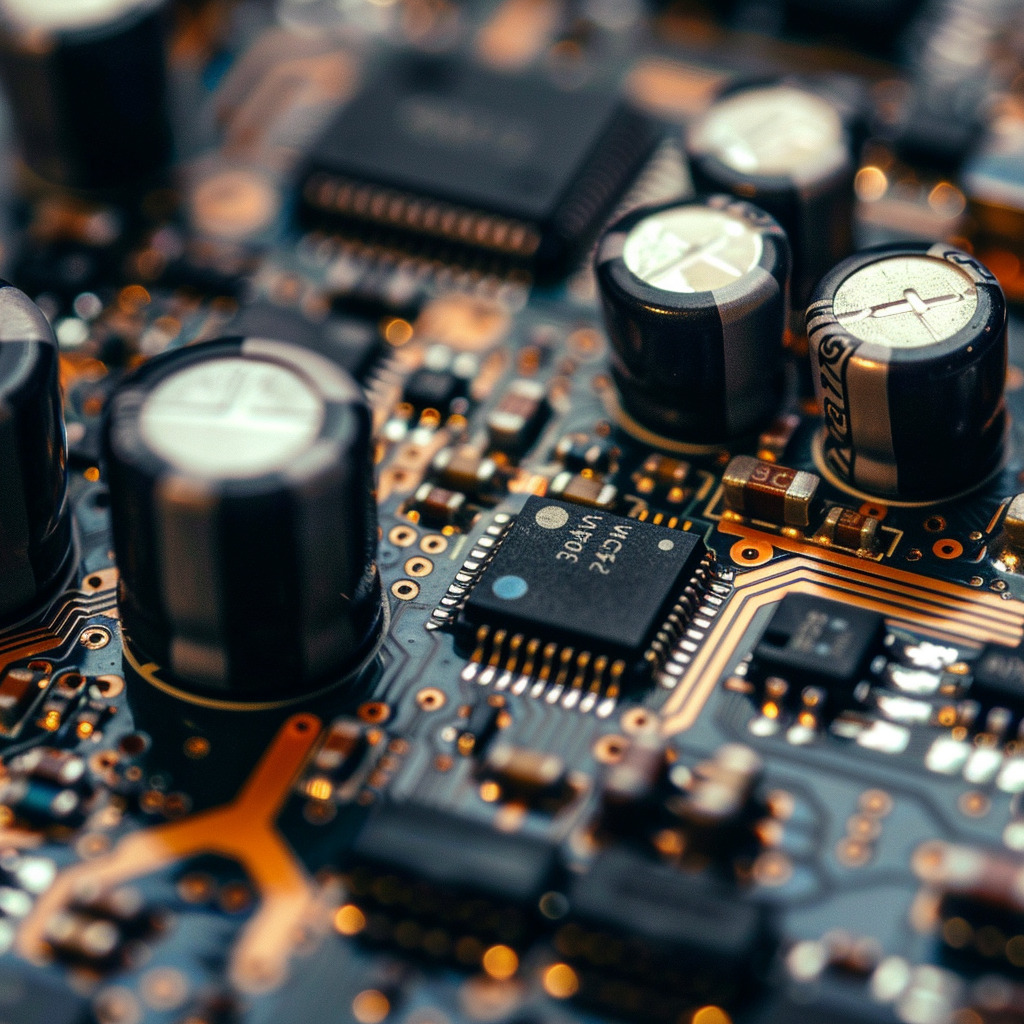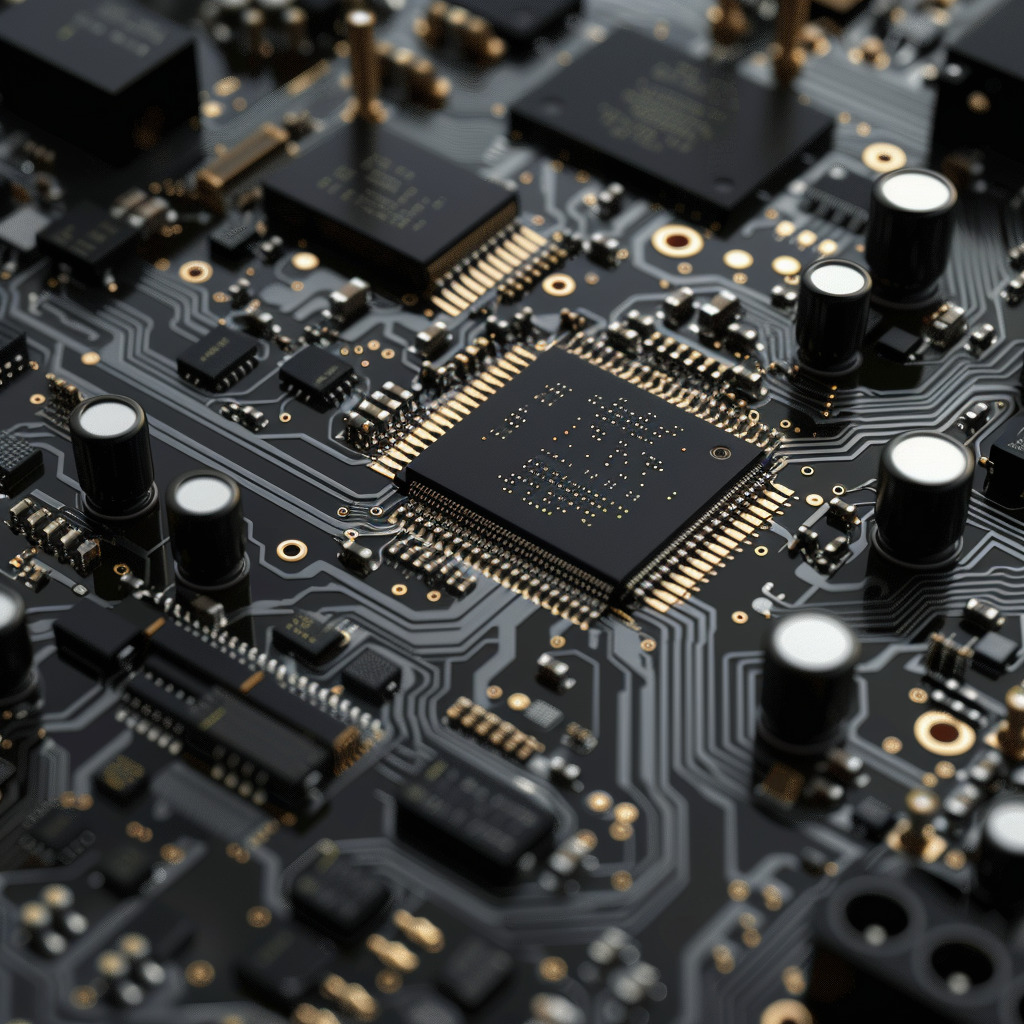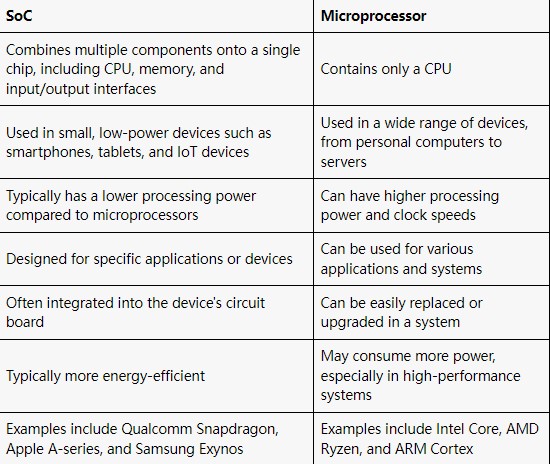Time: 2024-03-21 15:07:39View:
An SoC, or System on Chip, is a comprehensive electronic system that integrates various components and functions onto a single microchip. It brings together multiple subsystems, including processors, memory, input/output interfaces, and peripherals, into a unified unit. SoCs are extensively utilized in a wide range of electronic devices, such as smartphones, tablets, smart TVs, wearable devices, and even automotive systems.
For your reference, here is a article that you can check it: What is System on a Chip?
A microprocessor is a programmable electronic device that serves as the central processing unit (CPU) of a computer system. It is an integrated circuit (IC) that contains the functions of a computer's arithmetic logic unit (ALU), control unit, and memory management unit (MMU). The microprocessor is responsible for executing instructions and performing calculations, making it the "brain" of the computer.
Let's explore its components and features:
IC: An integrated circuit, also known as an IC, is a single chip that houses a microprocessor. This microprocessor is constructed using semiconductor technology and contains millions or even billions of transistors. These transistors are the building blocks of the microprocessor's functionality.
ALU: The arithmetic logic unit, or ALU, is a crucial component within the microprocessor. It is responsible for performing various arithmetic operations such as addition, subtraction, multiplication, and division. Additionally, the ALU carries out logical operations like AND, OR, and NOT. It executes calculations and manipulates data based on the instructions provided by the computer program.
CU: The control unit, or CU, plays a vital role in the microprocessor's functioning. It handles the task of fetching instructions from memory, decoding them, and executing them in the correct sequence. The control unit coordinates the activities of different components within the microprocessor, ensuring the accurate execution of instructions.
MMU: The memory management unit, or MMU, is responsible for managing memory-related operations. It performs tasks such as translating virtual memory addresses to physical memory addresses, managing memory allocation and deallocation, and providing memory protection. The MMU enables the microprocessor to effectively access and interact with the computer's memory hierarchy.
ISA: The instruction set architecture, or ISA, defines the specific set of instructions that a microprocessor can execute. It specifies the operations that the microprocessor is capable of performing, the data types it can handle, and the format of instructions. Different microprocessors have their own unique ISAs, such as x86, ARM, MIPS, and PowerPC, each with distinct characteristics.
Clock Speed: Microprocessors operate at a specific clock speed, which is measured in Hertz (Hz). The clock speed determines the number of instructions the microprocessor can execute per second. Generally, higher clock speeds result in faster processing, but they can also lead to increased power consumption and heat generation.
Pipelining and Caching: Advanced techniques such as pipelining and caching are commonly utilized in microprocessors to enhance efficiency. By allowing the microprocessor to execute multiple instructions simultaneously, pipelining enables faster overall processing. On the other hand, caching involves storing frequently accessed data closer to the microprocessor, thereby reducing the time required to retrieve information from memory.
Parallelism: Modern microprocessors incorporate various forms of parallelism to improve performance. This includes instruction-level parallelism, where multiple instructions are executed concurrently, and data-level parallelism, which involves processing multiple data elements simultaneously. Technologies like multi-core processors and vector processing further exploit parallelism to achieve faster computation.
Compatibility: Microprocessors are specifically designed to be compatible with particular computer architectures and software. This compatibility ensures that programs and operating systems developed for a specific microprocessor or ISA can run on compatible systems without the need for significant modifications.

The features of microprocessors can be found in many aspects. Let me tell you one by one.
1. Instruction Set: Microprocessors support a specific instruction set, which defines the set of operations that can be executed. The instruction set includes basic arithmetic and logical operations, control flow instructions, memory access instructions, and I/O instructions. Different microprocessor architectures may have varying instruction sets, each optimized for specific applications or design philosophies.
2. Registers: Microprocessors have internal storage units called registers that hold data and instructions during execution. These registers are usually faster to access than main memory, allowing for quicker data manipulation and processing. Registers are categorized based on their specific roles, such as general-purpose registers, special-purpose registers (e.g., program counter, stack pointer), and floating-point registers (for handling floating-point arithmetic).
3. Cache Memory: Microprocessors often have cache memory, which is a smaller and faster memory located closer to the CPU than main memory. Caches store frequently accessed instructions and data, reducing the time it takes to retrieve them from slower main memory. Cache memory operates on the principle of locality, exploiting the fact that recently accessed data is likely to be accessed again in the near future.
4. Instruction Pipelining: Instruction pipelining is a technique used in microprocessors to enable parallel processing of instructions. It divides the execution of instructions into multiple stages, allowing different stages to work concurrently. Each stage performs a specific operation, such as instruction fetch, decode, execute, and write back. Pipelining increases instruction throughput and improves overall performance by overlapping the execution of multiple instructions.
5. Superscalar Execution: Superscalar microprocessors have the ability to execute multiple instructions simultaneously. They achieve this by incorporating multiple execution units within the CPU, allowing for parallel processing of instructions. Superscalar processors analyze the instructions to identify independent operations that can be executed concurrently, improving the efficiency of instruction execution.
6. Branch Prediction: Branch prediction is a feature in microprocessors that attempts to guess the outcome of conditional branches (e.g., if-else statements, loops) before the actual result is determined. Predicting branches correctly allows the microprocessor to fetch and execute instructions speculatively, minimizing pipeline stalls caused by waiting for the branch outcome. Advanced branch prediction algorithms analyze program behavior and patterns to make accurate predictions.
7. Virtualization Support: Many modern microprocessors include hardware support for virtualization. This feature allows multiple virtual machines to run simultaneously on a single physical machine, providing isolation and resource management. Virtualization support enables efficient execution of virtualized environments, making it easier to consolidate multiple systems onto a single hardware platform.
8. Power Management: Microprocessors often incorporate power management features to optimize energy consumption. These features include clock frequency scaling, where the processor dynamically adjusts its clock speed based on the workload to save power. Sleep modes and idle states are also implemented, allowing the processor to reduce power consumption during periods of inactivity.
9. Security Features: Microprocessors include various security features to protect against threats such as unauthorized access, data breaches, and malware attacks. These features may include hardware-enforced memory protection, encryption and decryption capabilities, secure boot mechanisms, and support for secure execution environments, such as trusted execution environments (TEEs) or secure enclaves.
10. Scalability: Microprocessor designs often provide scalability, enabling the creation of processors with different performance levels and capabilities while maintaining compatibility. This allows manufacturers to produce processors tailored to specific applications or target markets while leveraging a common architecture and software ecosystem.
These are just some of the features and characteristics found in modern microprocessors. The field of microprocessor design and development continues to evolve, with new technologies and enhancements being introduced to improve performance, energy efficiency, and security.

Microprocessors offer several advantages and disadvantages that should be considered when choosing them for a particular application. Let’s discover one by one!
Advantages of Microprocessors:
Speed and Efficiency: Microprocessors are designed to process calculations and instructions at high speeds, making them efficient for computing tasks. They can handle large amounts of data quickly, thanks to features like pipelining, caching, and parallelism.
Compact Size: Being integrated circuits, microprocessors can fit a large number of transistors and functional units into a small physical space. This makes them ideal for creating portable devices like smartphones, tablets, and wearable technology.
Versatility: Microprocessors are programmable and can execute a wide range of software applications. They are used in various devices and systems such as personal computers, servers, consumer electronics, and more. Their versatility allows for software customization and enables them to be used in diverse applications.
Cost-Effectiveness: With advancements in semiconductor manufacturing and economies of scale, microprocessors have become more affordable over time. Mass production has made them accessible to a wide range of applications and industries, making them cost-effective.
Upgradability and Compatibility: Microprocessors are compatible with specific instruction set architectures (ISAs), allowing for software and application portability across different systems. This also enables users to upgrade their systems by replacing the microprocessor with a more powerful model without significant changes to the system infrastructure.
Integration and System Integration: Microprocessors can integrate multiple functions and components onto a single chip, simplifying system design and reducing the need for external components. This leads to smaller and less complex electronic devices, often resulting in improved reliability and performance.
Disadvantages of Microprocessors:
Heat Generation: Microprocessors generate heat during operation, and managing this heat can be a significant challenge. High-performance microprocessors can produce substantial amounts of heat, requiring effective cooling mechanisms such as heatsinks, fans, or liquid cooling systems. Inadequate cooling can lead to overheating, which can degrade performance or even damage the microprocessor.
Power Consumption: Microprocessors can consume significant amounts of power, especially in high-performance systems. This high power consumption can result in increased energy costs and may require additional power management measures. To mitigate this drawback, manufacturers have focused on designing power-efficient microprocessors.
Complexity: Microprocessors are intricate electronic devices with complex architectures and features. Designing, manufacturing, and programming them require specialized knowledge and expertise. This complexity can result in higher development costs, longer design cycles, and potential challenges in debugging and troubleshooting.
Security Vulnerabilities: Like any computing system, microprocessors can be vulnerable to security threats. Exploits such as side-channel attacks, speculative execution vulnerabilities, and firmware vulnerabilities have been discovered in microprocessors in the past. Maintaining the security and resilience of microprocessors is an ongoing challenge that requires constant updates and vigilance from manufacturers.
Obsolescence: The rapid pace of technological advancement means that microprocessors can become outdated relatively quickly. Newer, more powerful microprocessors are regularly introduced, making older models obsolete. This can pose challenges for long-term support, compatibility with software and hardware, and the need for frequent system upgrades.
Despite these challenges, microprocessors have greatly impacted the computing world and enabled numerous technological advancements. Manufacturers continue to work on addressing these challenges and improving the performance, efficiency, and security of microprocessors.
Differences between Microprocessors and SoC are as follows:

In summary, SoCs and microprocessors have some key differences that make them suitable for different applications. SoCs are compact, low-power chips that combine multiple components, while microprocessors are single CPUs with higher processing power. SoCs are commonly used in small devices like smartphones, while microprocessors are used in a wide range of systems. SoCs are designed for specific applications, whereas microprocessors are more versatile. Additionally, SoCs are often integrated into the device's circuit board, while microprocessors can be easily replaced or upgraded. Despite their differences, both SoCs and microprocessors have played a significant role in advancing technology and improving our daily lives.